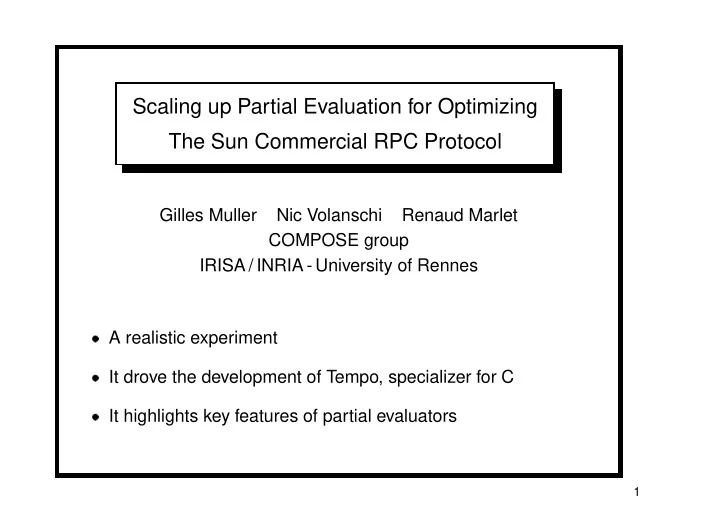

Scaling up Partial Evaluation for Optimizing The Sun Commercial RPC Protocol Gilles Muller Nic Volanschi Renaud Marlet COMPOSE group IRISA / INRIA - University of Rennes � A realistic experiment � It drove the development of Tempo, specializer for C � It highlights key features of partial evaluators 1
Overview of the talk � Sun RPC � Opportunities for specialization � Application of Tempo � Discussion on important features 2
Motivation What is RPC? RPC makes a remote procedure look like a local one Client Stub Server Stub Marshal Unmarshal RPC RPC execution Call Unmarshal Marshal Application space System space Receive Send results results Send Receive arguments arguments 3
Motivation Why optimize the Sun RPC? � Well recognized standard – distributed system services: NFS, NIS – distributed computing environments: PVM, Stardust � Performance is critical – manual: error prone, does not scale up – re-implementation: not compatible with the standard ) partial evaluation: reuse of existing code 4
Sun RPC Architecture � A set of micro-layers � Highly generic procedures � IDL and rpcgen: typedef struct { int int1, int2; } pair; program RMIN_PROG { version RMIN_VERS { int RMIN(pair) = 0; } = 1; } = 0x20000007; ) invariant for specialization 5
Sun RPC Example: minimum of two integers (client encoding) arg.int1 = ... arg.int2 = ... rmin_1(&arg) clnt_call() // Transport protocol switch clntudp_call() // UDP generic procedure call xdr_pair() // Encode 2 integers (rpcgen) xdr_int() // Integer size switch xdr_long() // Encoding/decoding XDR_PUTLONG() // Output protocol switch xdrmem_putlong() // Write buffer/check overflow htonl() // Big/little endian 6
Opportunities for Specialization Propagation of Exit Status bool_t xdr_pair(xdrs, objp) { if (! xdr_int(xdrs, &objp->int1) ) { return (FALSE); } if (! xdr_int(xdrs, &objp->int2) ) { return (FALSE); } return (TRUE); } STAT DYN Needed: interprocedural, partially static structures, return sensitivity 7
Opportunities for Specialization Elimination of Encoding/Decoding Dispatch bool_t xdr_long(xdrs,lp) { if( xdrs->x_op == XDR_ENCODE ) return XDR_PUTLONG(xdrs,lp); if( xdrs->x_op == XDR_DECODE ) return XDR_GETLONG(xdrs,lp); if( xdrs->x_op == XDR_FREE ) return TRUE; return FALSE; } STAT DYN Needed: interprocedural, partially static structures, return sensitivity 8
Opportunities for Specialization Elimination of Buffer Overflow Checking bool_t xdrmem_putlong(xdrs,lp) { if((xdrs->x_handy -= sizeof(long)) < 0) return FALSE; *(xdrs->x_private) = htonl(*lp); xdrs->x_private += sizeof(long) ; return TRUE; } STAT DYN Needed: interprocedural, partially static structures, return sensitivity, use sensitivity (different uses may have different binding times) 9
Application of Tempo Specialized Arguments Encoding (sugared) void xdr_pair(xdrs,objp) { *(xdrs->x_private) = objp->int1; xdrs->x_private += 4u; *(xdrs->x_private) = objp->int2; xdrs->x_private += 4u; } 10
Application of Tempo Manual Interventions � Control flow for exceptions � Exposition of specialization opportunities if (inlen == expected) { inlen = dyn; inlen = expected; code(inlen); ) code(inlen) ; = } else code(inlen); Needed: flow sensitivity STAT DYN 11
Application of Tempo Speedups 4 PC/Linux Speedup Ratio for RPC Round Trip Time IPX/Sunos PC/Linux - Ethernet 100Mbits Speedup Ratio for Client Marshalling IPX/Sunos - ATM 100Mbits 1.6 3 1.4 2 1.2 1 1.0 20100 250 500 1000 2000 20100 250 500 1000 2000 Array Size (4-Byte Integers) Array Size (4-Byte Integers) 12
Discussion Key Features in Binding-Time Analyses Essential for specializing the Sun RPC: � Interprocedural analyses � Partially static structures � Use sensitivity � Return sensitivity � Flow sensitivity Useful but not essential: � Context sensitivity 13
Discussion User Interface Crucial to the “tuning” phase: � Colors for binding times and program transformations � Aliases � Polyvariance � Use of global variables Useful features: � Analysis and specialization context Drawback: � Code transformation (SUIF , Tempo) 14
Discussion Module-Oriented Specialization � Analysis context prior to code to specialize � Analysis context after to code to specialize � Evaluation of external calls � Abstract description of external functions – binding times – aliases 15
Conclusion � Large scale experiment on existing, mature, commercial code � Significant speedups � Key features in BTA � Key features in user interface � PE for suppressing modularity and genericity overhead 16
Recommend
More recommend